
Alfred Stieglitz was an American photographer and modern art promoter who was instrumental over his 50-year career in making photography an accepted art form. In addition to his photography, Stieglitz was known for the New York art galleries that he ran in the early part of the 20th century, where he introduced many avant-garde European artists to the U.S. He was married to painter Georgia O'Keeffe.
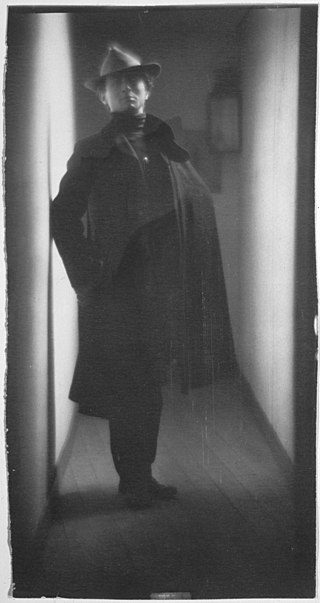
Edward Jean Steichen was a Luxembourgish American photographer, painter, and curator, renowned as one of the most prolific and influential figures in the history of photography.

Paul Strand was an American photographer and filmmaker who, along with fellow modernist photographers like Alfred Stieglitz and Edward Weston, helped establish photography as an art form in the 20th century. In 1936, he helped found the Photo League, a cooperative of photographers who banded together around a range of common social and creative causes. His diverse body of work, spanning six decades, covers numerous genres and subjects throughout the Americas, Europe, and Africa.
Uta Barth is a contemporary German-American photographer whose work addresses themes such as perception, optical illusion and non-place. Her early work emerged in the late 1980s and 1990s, "inverting the notion of background and foreground" in photography and bringing awareness to a viewer's attention to visual information with in the photographic frame. Her work is as much about vision and perception as it is about the failure to see, the faith humans place in the mechanics of perception, and the precarious nature of perceptual habits. Barth's says this about her art practice: “The question for me always is how can I make you aware of your own looking, instead of losing your attention to thoughts about what it is that you are looking at." She has been honored with two National Endowments of the Arts fellowships, was a recipient of the John Simon Guggenheim Fellowship in 2004‑05, and was a 2012 MacArthur Fellow. Barth lives and works in Los Angeles, California.
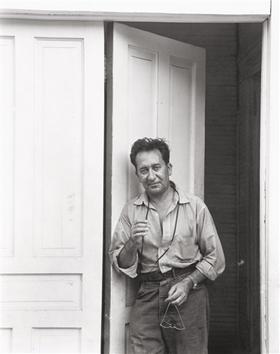
Aaron Siskind was an American photographer whose work focuses on the details of things, presented as flat surfaces to create a new image independent of the original subject. He was closely involved with, if not a part of, the abstract expressionist movement, and was close friends with painters Franz Kline, Mark Rothko, and Willem de Kooning.

Gertrude Käsebier was an American photographer. She was known for her images of motherhood, her portraits of Native Americans, and her promotion of photography as a career for women.
Thomas Joshua Cooper is an American photographer. He is considered among the premier contemporary landscape photographers.
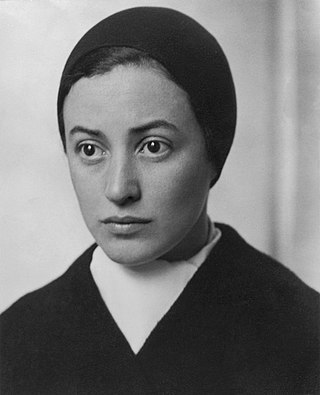
Dorothy Norman was an American photographer, writer, editor, arts patron and advocate for social change.

The Steerage is a black and white photograph taken by Alfred Stieglitz in 1907. It has been hailed by some critics as one of the greatest photographs of all time because it captures in a single image both a formative document of its time and one of the first works of artistic modernism.
There were men and women and children on the lower deck of the steerage. There was a narrow stairway leading to the upper deck of the steerage, a small deck right on the bow with the steamer.
To the left was an inclining funnel and from the upper steerage deck there was fastened a gangway bridge that was glistening in its freshly painted state. It was rather long, white, and during the trip remained untouched by anyone.
On the upper deck, looking over the railing, there was a young man with a straw hat. The shape of the hat was round. He was watching the men and women and children on the lower steerage deck...A round straw hat, the funnel leaning left, the stairway leaning right, the white drawbridge with its railing made of circular chains – white suspenders crossing on the back of a man in the steerage below, round shapes of iron machinery, a mast cutting into the sky, making a triangular shape...I saw shapes related to each other. I was inspired by a picture of shapes and underlying that the feeling I had about life."
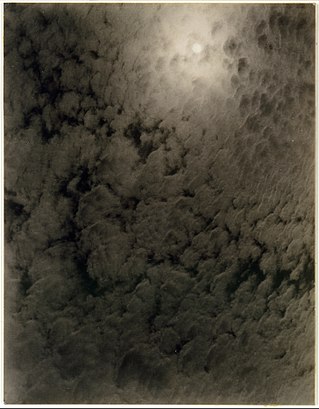
Equivalents is a series of photographs of clouds taken by Alfred Stieglitz from 1925 to 1934. They are generally recognized as the first photographs intended to free the subject matter from literal interpretation, and, as such, are some of the first completely abstract photographic works of art.
John Divola is an American contemporary visual artist and educator, living in Riverside, California. He works in photography, describing himself as exploring the landscape by looking for the edge between the abstract and the specific. He is a professor in the art department at University of California Riverside.
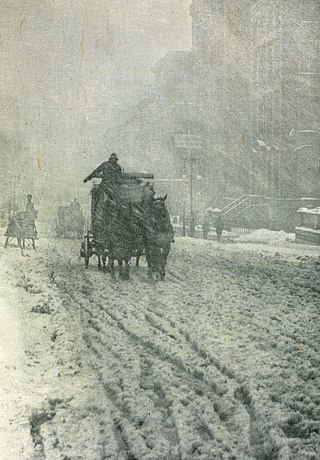
Winter, Fifth Avenue is a black and white photograph taken by Alfred Stieglitz in 1893. The photograph was made at the corner of the Fifth Avenue and the 35th Street in New York. It was one of the first pictures that Stieglitz took using a more practical hand camera after his return from Europe.

Spring Showers, the Coach is a black and white photograph taken by Alfred Stieglitz in 1899–1900. The picture was published in the Camera Notes journal in January 1902. Sometimes it is incorrectly presented as being taken in 1902.

Georgia O'Keeffe - Torso, also known as Georgia O'Keeffe - Nude, is a black and white photograph taken by Alfred Stieglitz in 1918. It is one of the more than 300 photographs that he took of his future wife, the painter Georgia O'Keeffe.

The Hand of Man is a black and white photograph taken by Alfred Stieglitz in 1902. This is one of the pictures he took concerning urban life and would be published in the first issue of his magazine Camera Work, in January 1903. A note on this issue stated that “The Hand of Man.. is an attempt to treat pictorially a subject which enters so much into our daily lives that we are apt to lose sight of the pictorial possibilities of the commonplace.”
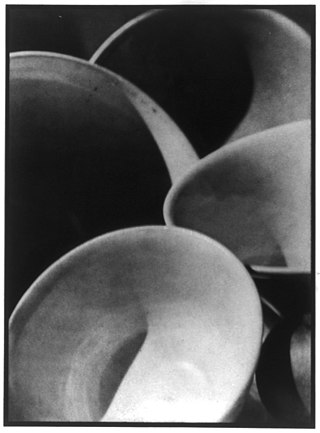
Bowls, also known as Abstraction, Bowls, is a black and white photograph taken by Paul Strand in 1916. The photograph has elements of cubism and abstractionism, and exemplifies his style at the time.

The White Fence, also known as The White Fence, Port Kent, New York, is a black and white photograph taken by American photographer Paul Strand, in 1916. The picture was published in the magazine Camera Work, in June 1917, whose editor was Alfred Stieglitz, where it was highly praised by him, specially for its "abstract qualities". It would be later published as part of Paul Strand: Portfolio Three (1976-1977).
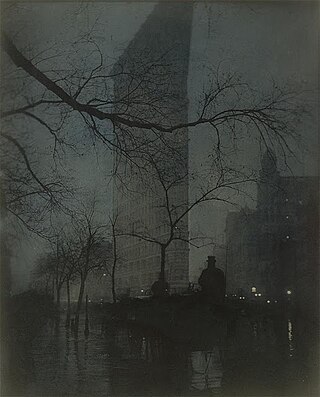
The Flatiron is a colored photograph made by Luxembourgish American photographer Edward Steichen. The photograph depicts the recently erected Flatiron Building in New York, taking inspiration from fellow photographers like Alfred Stieglitz, who had just photographed the building a year prior. The original negative was made in 1904 and spawned three platinum-gum exhibition prints in brown (1905), blue-green (1909), and yellow-green-black.

Balzac, the Open Sky is a black and white photograph taken by American photographer Edward Steichen in 1908. The photograph is part of a series created by Steichen that depict the statue of Honoré de Balzac by Auguste Rodin, executed in plaster, in 1898. The statue would eventually be cast in bronze and inaugurated in Paris, in 1939.
















